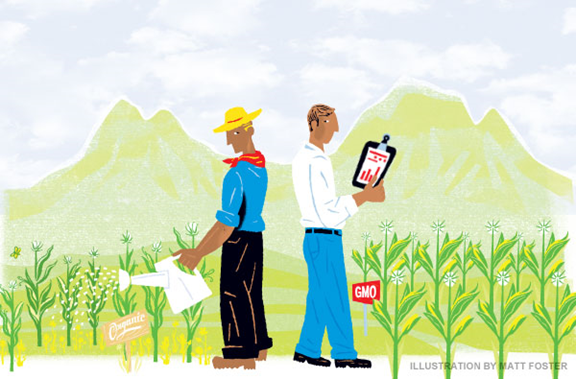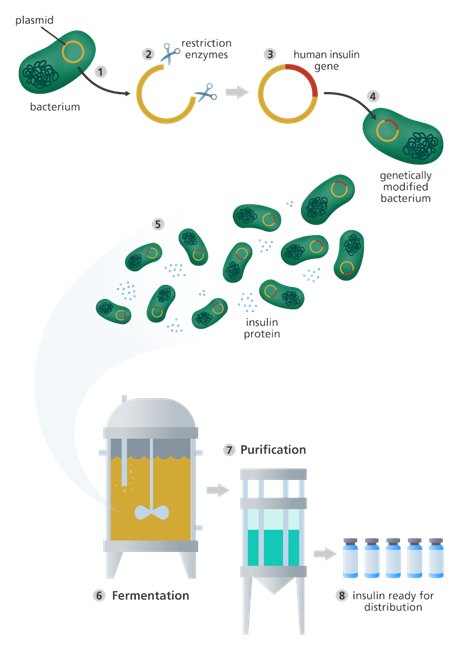Engineering bacteria into insulin-producing factories genetically
Nadwa Atwi. 02/19/2021

Ever since the concept of genetic engineering emerged in the early 1970s, various genetic discoveries have ensued. And although genetic engineering has stirred up plenty of controversy over the years, it remains the most important tool of biotechnology and one that has proved to be very promising, especially in the medical field.
What is genetic engineering?
Genetic engineering, also known as genetic modification, is the process of altering the DNA in an organism’s genome by swapping base pairs, deleting them or even introducing a whole gene to modify or enhance certain traits of the organism.
This technology has been applied in various areas. A simple example of genetic engineering in plants is providing them with herbicide resistance, which allows farmers to spray for weeds without damaging their crops. The first herbicide-resistant soybeans were introduced in 1996 by the American agrochemical company Monsanto under the title “Roundup Ready”. According to Beyond Pesticides, these crops have become prevalent in American agriculture with 93% of soybeans, 82% of cotton and 85% of corn engineered to be herbicide-resistant.
In medicine, a number of breakthroughs were made through genetic engineering. In addition to synthesizing human insulin using bacteria, scientists were also able to get bacteria to produce human growth hormone, alpha interferon and the hepatitis B vaccine.
Gene therapy is also a recent technology closely associated with genetic engineering. It involves manipulating human genes to treat genetic diseases as opposed to genetic engineering’s purpose of enhancing already normal genes.
According to Lumen Learning, gene therapy has been used lately in clinical trials to treat conditions like cystic fibrosis, AIDS and cancer.
The history of insulin
Diabetes is a disorder that causes the body’s blood glucose levels to rise to dangerously high levels. It’s a very common condition that can be treated by injecting insulin, which allows glucose to be taken up by the liver and other tissues. Consequently, cells obtain the glucose they require and blood glucose levels remain normal.
Initially, insulin was obtained from the pancreases of animals, primarily pigs and cows, and used safely to manage diabetes for years. But it came with its drawbacks and over time, cases of adverse reactions associated with animal-derived insulin were reported. Also, extracting insulin from animals wasn’t exactly cost-effective. According to Gene, 8,000 pounds of pancreas glands from 23,500 animals were required to make one pound of insulin.
In 1978, the biotechnology firm “Genentech” produced human insulin using the bacteria E. coli, making insulin the first-ever human protein manufactured through biotechnology.
And in 1982, the pharmaceutical company, Eli Lilly, introduced the first-ever genetically-engineered human insulin under the brand name “Humulin”.
How the process works

Since the bacterium E. coli is known for having the fastest reproduction rate among bacteria (they can double in number every 20 minutes!), it is the preferred organism for human insulin production.
First, the human insulin gene found in the human DNA is cut using a restriction enzyme. A small part of the bacterial plasmid (a circular piece of DNA independent from the bacterium’s chromosome) is also cut out using a restriction enzyme.
Ligase enzymes are used to insert the human insulin gene into the plasmid and join the two together. A recombinant plasmid, assembled out of fragments from various sources, is obtained.

The recombinant plasmid, now containing the insulin gene, is injected into a bacterial cell.
The human insulin gene is treated just like any other bacterial gene and is therefore transcribed into mRNA and then translated into proteins following the ordinary molecular machinery of protein synthesis. In this case, the protein of interest is called human insulin.
Bacteria are put in a fermenter (also known as a fermentation tank), which provides optimal conditions for bacterial growth. Bacteria can then reproduce rapidly in the tank, resulting in millions of insulin-gene-bearing bacteria that synthesize human insulin.
Since bacteria synthesize their own bacterial proteins in addition to the human insulin protein, the latter must be extracted and purified before packaging.
Biotechnology has drawn plenty of controversy despite all the breakthroughs it has led to. Several aspects of genetic engineering, in particular, were questioned. While the benefits of this field could be tremendous, many showed their apprehension over the consequences such a powerful tool can bring about. Since genetically-engineered organisms are still novel and not entirely understood, their release could present an ecological imbalance. And an accident in engineering the genetics of a bacteria or a virus, for example, could result in an unmanageable type of microorganisms that could lead to a fatal epidemic when released. There is no doubt that genetic engineering will still continue to raise many debates over the years, so further research will always be required in order to ensure the safety of any product produced using this precious but destructive tool.
Cover Photo: (Future of Life Institute)

Nadwa is a pharmacy student from Lebanon. She is a science enthusiast that loves to feed her curiosity by probing into the most unusual medical conditions. Through InterSTEM, Nadwa aspires to let people recognize just how fascinating science can be, and hopes to share her passion with them as well. In her free time, she enjoys reading novels and reviewing them on her blog, binge-watching anime and fangirling over her favorite Kpop groups.